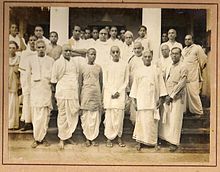Angavastra

An angavastra (plural, angavastram, Sanskrit: अङ्गवस्त्रम्) is a shoulder cloth or stole worn by men in India, especially in Maharashtra and South India. It is a single, rectangular piece of fabric and may have decorated borders. An angavastra may be worn with a dhoti and kurta. An angavastra may be offered as a mark of respect to guests, elders and gurus.[1]
Style and use[edit]
Angavastra is a simple loose garment, usually paired or matching with dhoti color, draped over the shoulders. It is a traditional wear of South India and a profound fashion statement.
Prime Minister Narendra Modi wore karai veshti dhoti, kurta, and angavastram, the traditional attire during his visit to Arjuna's Penance, Krishna's Butterball, the Pancha Rathas, and Shore Temple.[2][3] A weaver from Varanasi designed and wove a special silk angavastram incorporating Buddhist mantras for Narendra Modi.[4]
History[edit]
The angavastram, a traditional garment worn by men in parts of South India and Maharashtra, has a long history rooted in Indian culture. This unstitched, rectangular piece of fabric is draped over the torso and shoulder, serving practical and symbolic purposes. The origins of the angavastram can be traced back to ancient times. It is believed to have evolved from the uttariya, a similar garment worn around the shoulders or waist, as evidenced by sculptures found at historical sites such as Sanchi and Amaravati. The word "angavastram" is derived from Sanskrit, meaning "cloth for the body," reflecting its fundamental purpose.
Historically, the angavastram was typically made of handspun cotton yarn, crafted using simple machinery. With the industrialization of the textile industry, production methods evolved. While cotton remains popular for everyday wear, silk angavastrams are often used for religious and formal occasions. The use of raw matka silk is particularly preferred for religious leaders and practitioners.[5]
In recent years, the angavastram has gained recognition beyond its traditional contexts. Some educational institutions in India have adopted it as part of their convocation attire, replacing colonial-era black robes. For example, in 2023, the University of Delhi announced its decision to use angavastrams for its 99th convocation ceremony, citing a desire to move away from colonial influences.[6]
Despite its long history, the basic design and purpose of the angavastram have remained largely unchanged. It continues to be an important symbol of Indian culture, representing both tradition and practicality in modern times.
References[edit]
- ^ "Rátnagiri and Sávantvádi". Gazetteer of the Bombay Presidency. 10: 112. 1880. Retrieved 10 May 2021.
- ^ "Veshti-Shirt-Angavastram; PM Modi dons the traditional Tamil Nadu outfit for Jinping meet". Zee News. 2019-10-11. Retrieved 2021-01-22.
- ^ "veshti: Latest News & Videos, Photos about veshti | The Economic Times". The Economic Times. Retrieved 2021-01-22.
- ^ "Special 'angavastram' awaits PM Modi in Varanasi". www.daijiworld.com. Retrieved 2021-01-22.
- ^ "Information About Silk Dhoti and Angavastram". Utsavpedia. 2017-03-19. Retrieved 2024-07-11.
- ^ "Delhi University to replace robes with angavastra for convocation: Why are robes and caps worn at graduation?". The Indian Express. 2023-02-17. Retrieved 2024-07-11.
